The Boyd Disaster
THE BOYD DISASTER.
by Cormac F. Lowth
And such the trust that still were mine,
Though stormy winds swept o’er the brine,
Or through the tempest’s fiery breath,
Raise me from sleep to wreck and death.
Emma Hart Willard,
Rocked in the Cradle of the Deep.
February 1861 will be remembered not only for the loss of a great many ships around Dublin Bay but also for the death of a heroic man, who, with some of his companions, attempted to save the lives of some members of shipwrecked crews in Kingstown. This was Captain John McNeil Boyd of the guard-ship H. M. S. AJAX.
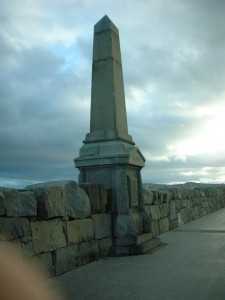
Boyd Monument on DúnLaoighre Pier
January and February have always been the worst months for storms around the east coast of Ireland and the year 1861 was no exception as the customary storms of February proved to be exceptionally severe. One of the worst storms on record began on Friday 8th and continued to blow with increasing severity for two days. Northerly gales are a rarity on the east coast and those that occur usually do so suddenly. At around midnight on the 8th, the wind had swung around to the north east and by the early hours of the following morning it had increased to strong gale force directly from the north. One of the first casualties of the storm was the schooner CLYDE of 100 tons which went on the rocks outside the East Pier of Kingstown harbour with a cargo of salt. She was bound for Cork from Runcorn and had attempted to shelter in Kingstown. The crew managed to scramble to safety on the east pier.
The storm increased in force and many more ships were wrecked along the coast. A dense snowstorm began in the early hours of Saturday morning and a schooner went down with all hands on the Burford Bank, which straddles the mouth of Dublin Bay. This was reported by the Cross Channel paddle-wheeled steamer PRINCE, which had a particularly rough passage from Liverpool and had one of the paddle boxes which enclosed the paddle wheels torn off by a huge wave as she approached Dublin Bay. The master of the PRINCE, Captain Reynolds, was reported to have been greatly upset at being unable to render any assistance to the schooner as it went down so quickly. On Saturday morning, the CLYDE, which was still on the rocks outside the east pier, was lifted up by the force of the sea and driven in through the harbour mouth and she went aground on the rocks near where the present Irish Lights depot stands. She was smashed to pieces shortly after. Huge waves were by now washing over the piers and some of the great boulders upon which the piers are built were being tossed about like pebbles.
The harbour at Kingstown, (Dun Laoghaire) which had been built as a harbour of refuge, is particularly vulnerable when exposed to northerly winds. This might perhaps have been averted had the piers been built in an overlapping way or if the harbour mouth had been made narrower, although, while making the interior of the harbour safer, these measures may have made entrance to the harbour more difficult. Throughout the history of the harbour many vessels seeking shelter in Kingstown during rough weather missed the harbour-mouth and came to grief. During the storm of 1861 a great many vessels were wrecked inside the harbour due to this exposure to northerly weather.
The Whitehaven collier LEVEN was wrecked in the harbour on the Saturday morning along with some ketches from Strangford, which had cargos of potatoes. It has been estimated that 135 ships were posted as missing around the British Isles during the storm. At least 15 of these were wrecked in Dublin Bay and fourteen more occurred between Howth and Wicklow Head. Bodies were washed ashore for many weeks afterwards.
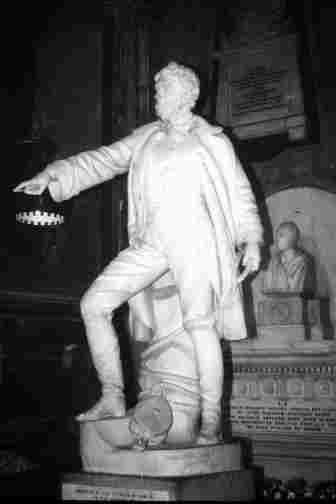
Statue of Boyd, by Farrell, in St Patrick’s Cathedral
During the morning, as the storm continued to blow with increased ferocity, a flotilla of small trading vessels were seen running before the storm towards Kingstown Harbour. Some of these would successfully reach the harbour where most would ride out the worst effects of the storm. The collier WANDERER of Whitehaven sank in the Bay and some of the wreckage was washed into Kingstown Harbour. Another WANDERER from Dundalk was wrecked in the harbour. Thirty years later a famous vessel of this name would successfully find shelter in Kingstown after being partially dismasted in the Irish Sea. Other ships wrecked in the harbour and surrounding area included ROYAL SOVERIEGN from Portaferry, CAROLINE of Workington, RANGER from Stranraer, MOSES of Troon, HELEN, HERO of Ardrossan , CLANS from Ayr, KING OLAVE of Drogheda, SYLPHE of Bordeaux and LIVELY. The brig MARYANNE was brought ashore with great skill at Sandycove and all of the crew were saved.
The schooner MARY of Belfast was not as lucky as she missed the harbour-mouth and went ashore on the rocky coast near the bottom of Burdett Avenue in Sandycove. The crew were fortunately saved as the ship broke up in the heavy surf. They were pulled ashore by many of the local people and a Mr. Perrin and a Mrs. King received special mention in this regard. A small brig entered Dalkey Sound where she was overcome by the huge waves and she sank in full view of many onlookers on the shore. Most of her crew were saved through the efforts of the coastguards. The mail-boat from Kingstown was forced to turn back on Saturday morning as she had part of the foredeck ripped off which allowed a large quantity of water down into the mail sorting room which saturated many of the bags of mail.. It was necessary to take the mail ashore to have it dried out. The damage sustained cost over five hundred pounds to repair, a sizeable sum at that time.
Among the vessels lost at Howth was the ELIZABETH of Drogheda while further north at Skerries, the local lifeboat saved the entire crew of a brig which went ashore and was shortly after smashed to pieces. Two colliers from Whitehaven, the brigantine INDUSTRY and the brig NEPTUNE, had attempted to enter the harbour but were washed onto the rocks at the back of the east pier at Kingstown. Both of these vessels had lost some of their sails. The tragedy of the loss of some members of both crews was to be added to by further tragic losses, the pattern of which has been all too familiar in the annals of maritime rescue, as some of the rescuers were swept to their doom.
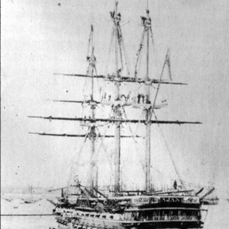
The Guardship AJAX in Kingstown (DúnLaoghaire) Harbour
Captain John McNeil Boyd from County Derry was master of the Royal Naval guard-ship AJAX that was stationed in Kingstown. The ship was normally moored beside the East Pier in the harbour near where the tragedy took place. When word of the plight of the two vessels on the outside of the pier was given to Captain Boyd at about 9.30 a.m. by the officer of the watch, Lieutenant Arthur Morell, he immediately ordered a boat to be manned. One of the officers of the AJAX, Lieutenant Hugh McNeil Dyer, had been assisting the coastguards with gunner George Farrin and a boat’s crew in another part of the harbour where ships were in distress and he arrived back alongside the Ajax. Captain Boyd and some additional crew members, which made a total of fourteen, went aboard this boat with heaving lines, rockets and ropes, and they rowed over to the steps on the pier at a point near to where the ships were being wrecked. Various other people were on the pier, where waves were now coming over the top in places. The NEPTUNE was being pounded against the jagged rocks at the base of the pier and the INDUSTRY was in a similar plight close by. Captain Boyd immediately ordered a rocket fired to take a line to the NEPTUNE but this was blown back by the force of the gale. The crew of the INDUSTRY managed to get a line ashore but it snapped like thread when it was made fast on the shore. As Captain Boyd and some of the naval party, who were lashed together with ropes, ventured down the rocky slope towards the crew of the NEPTUNE, who were now all in the water and attempting to struggle ashore, the master of the INDUSTRY, James Collins, was swept off the bow of the vessel as he attempted to get another line ashore. His brother, Daniel Collins was also swept off into the raging surf but he was rescued by Constable Dineen of the Dublin Metropolitan Police force (no. 82F) who managed with the help of another man to approach the waters edge and pull him to safety. Many more men from AJAX and some civilians had joined the rescue party.
Lieutenant Dyer then ventured down to try to rescue a man who was face down in the surf but as he began to drag him in, a huge wave dashed him against the rocks and swept away seaman Thomas Murphy who had followed Dyer with a coil of rope. Dyer’s head was lacerated and he was knocked unconscious momentarily. As the wave retreated he was pulled to safety by William Ferris. He regained consciousness almost immediately, just in time to see a tremendous wave sweep in and along the pier which engulfed everything. Captain Boyd and a party of men were at the water’s edge attempting to drag a man ashore in a lifebelt. When the huge wave receded, the captain and five of the rescuers were nowhere to be seen. Captain Boyd had been heard to remark “Life is sweet” just beforehand. Mr. John Walsh, the Lloyd’s agent in Dublin, was knocked backwards by the same huge wave and he had several ribs broken and suffered lacerations to his head and neck. Another of the rescue party, Mr. Anderson, was also being swept away but was saved by catching his thumb in a crack between some of the rocks. Lieutenant Hutchison, The Harbour Master was washed under by the wave but he emerged unscathed. Only one man, Fenning, was saved from the NEPTUNE having been dragged ashore by constable Dineen while all but one of the crew of the INDUSTRY came ashore safely.
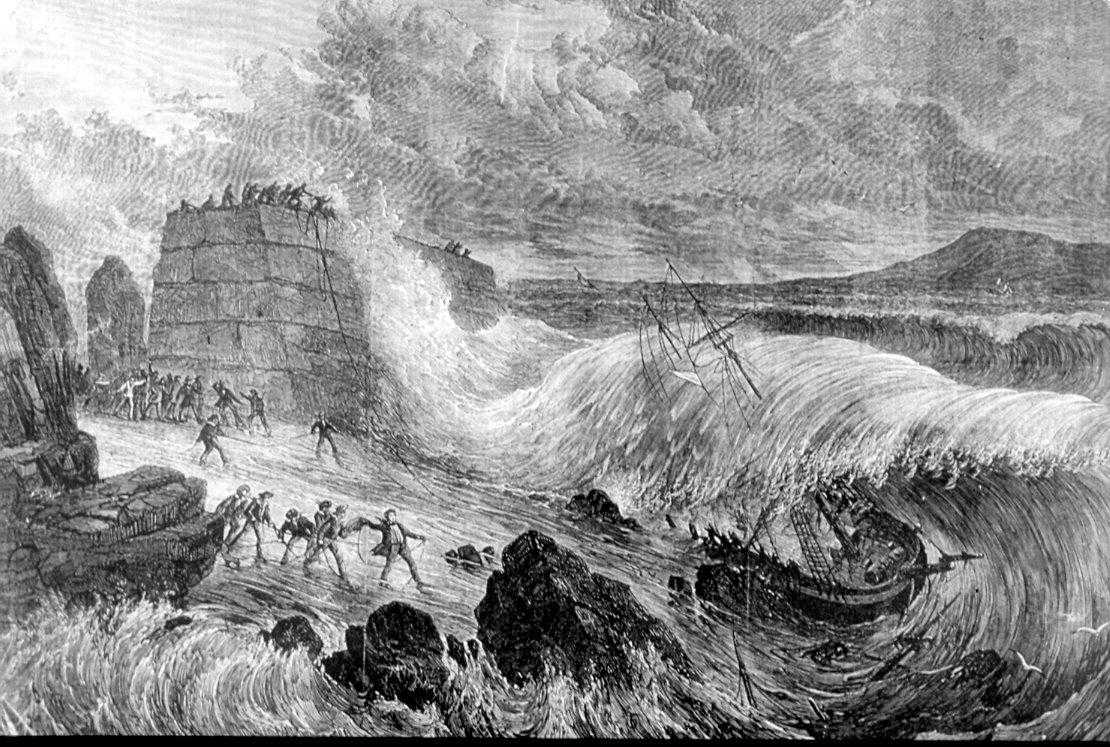
Site of the rescue on the East Pier
Almost all of the rescue party were badly lacerated and bruised and they were treated by the surgeon of the AJAX, Mr. Buchanan. Mr. Walsh had a very bad head wound and had to be taken to hospital. As he was being helped into a cab, the driver refused to take him stating that he did not want blood all over the inside of his cab. The driver was then knocked down by the irate crowd and the cab, with Mr. Walsh now inside, was taken to the local hospital. Lieutenant Morell led search parties throughout the rest of the day and a total of eight bodies were found, which included four of the crew of AJAX and all were brought to the revenue store. A total of ten lives were lost in addition to the six from AJAX. Captain Boyd’s body was not found until much later.
An inquest was convened next morning at 11 a.m. by the coroner, Mr. Henry L. Harty and a verdict was quickly arrived at that the men from the AJAX had drowned while trying to save the crew of the NEPTUNE. They next considered the deaths of the seamen from NEPTUNE and INDUSTRY and there was much discussion about the availability of ropes and other rescue equipment. It emerged that by the time the Manby rocket equipment had been brought around from the West pier, the vessels were a total loss and the whole episode had reached its grim conclusion with the death of Captain Boyd, his colleagues and the unfortunate crewmen. A verdict of death by drowning was reached. The search continued for Boyd’s body but only his shirt with the cufflinks attached, one of his boots and a muffler were found. A reward of five pounds was offered to anyone finding the body. The storm had abated by now and evidence of the many ships that had been wrecked was scattered about the harbour and the adjoining shoreline. The harbour master and secretary of the Kingstown lifeboat, Lieutenant William Hutchison R.N., was a man who displayed boundless energy, courage and resourcefulness at shipwreck rescues for decades at Kingstown and other areas around Dublin Bay. He was criticised very unfairly in the press for his failure to launch the lifeboat during the rescue. This prompted him to write the following reply to the criticism in a letter to the Irish Times.

Inscription on the Boyd monument, DúnLaoghaire pier
—– My history at this port has always shown that when my brother seamen were in danger, I have never hesitated to go to their rescue in the lifeboat. I should have endeavoured to get volunteers had I seen the slightest prospect of saving the unfortunate crews; but even if there was time to get the boat round, I am certain it would have been the most rash act of my life; and when once the NEPTUNE struck the outside of the East Pier, had the boat approached to take the crew from to windward, as I swore in my evidence before the coroner but not stated by your reporter, the lifeboat would have been swept by the broken and rolling sea right over the wreck, adding twelve more seamen to the destruction of life.
Lieutenant Hutchison was one of the very few Irish recipients of the R.N.L.I. gold medal for a lifeboat service to the brig DUKE off Sandycove in 1829.
On Tuesday a diving bell and some divers were brought over to Kingstown from Holyhead to aid in the search and they immediately found the body of Alexander Forsyth, one of the seamen from AJAX. Lieutenant Dyer, in the gunboat RAINBOW, took the unusual step of continually firing cannon in the vicinity of the East pier and Scotsmans Bay on the assumption that the shock waves would make the body rise to the surface. On the following day, the funerals of the five seamen from AJAX, who had been lost with Boyd, took place to Carrickbrennan Cemetery in Monkstown, led by the band from AJAX. The coffins were placed on gun carriages flanked by Royal marines. Reverend Howe, the chaplain the AJAX read the service for Forsythe and Russell who were of the protestant faith. A firing party fired three volleys over the graves.
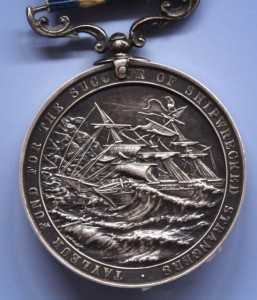
Tayleur Medal
A public meeting was held in the Mansion House in Dublin on Feb. 22nd.for the purpose of organising a fund to erect a suitable memorial to Captain Boyd and the men of AJAX who had been lost. Also, to suitably reward the men of the AJAX who had participated in the rescue and survived and to make some provision for the families of those who were lost. On Monday, Feb. 25th the body of Captain Boyd was finally discovered about fifty yards from where the wrecks occurred. The divers had continued their search and at 10.30 a.m. Diver Prichard found the body lying on the sand just clear of the rocks and he brought it to the surface. There was unusual clarity in the water that morning. The body was brought aboard AJAX where it was laid out on the quarter deck in preparation for the funeral on the following Friday. The Lord Lieutenant visited the Captain’s widow, Mrs. Cordelia Boyd and her two sons who lived aboard AJAX. The coffin was carried by the sailors up the East Pier, followed by the entire ship’s compliment, to the railway station, where it was placed aboard a carriage and taken to Dublin. When the train arrived in the city, the coffin was placed on a gun carriage drawn by eight horses and the cortege proceeded to St Patrick’s Cathedral. Huge crowds were in attendance along the entire route. The funeral service was conducted by the Dean of St. Patrick’s and the attendance included the Lord Lieutenant, the Lord Mayor and many other dignitaries. Captain Boyd’s big Newfoundland dog was seen near the coffin. A large military and naval guard of honour fired three volleys as a final salute over the grave as the coffin was lowered. Captain Boyd’s grave can be seen today in the little graveyard at the right hand side of St. Patrick’s Cathedral. It lies almost in the centre and is covered by a large flat stone with an inscription describing the sad events.
A fine life-sized white marble statue, which was sculpted by Thomas Farrell and paid for from the Public subscriptions, stands today inside Saint Patrick’s cathedral. It depicts Boyd standing in naval uniform and sea-boots with one arm outstretched. The inscription on the plinth reads,
Safe from the rocks whence swept thy manly form,
The tide’s white rush, the stepping of the storm.
Borne by a public pomp by just decree,
Heroic sailor from that fatal sea,
A city vows this marble unto thee.
And here in this calm place where never din
Of Earth’s great water floods shall enter in,
Where to our human hearts two thoughts are given,
One, Christ’s self sacrifice, the other Heaven.
Here it is meet for grief and love to crave,
The Christ taught bravery that died to save,
The life not lost but found beneath the wave.
All thy billows and thy waves passed over me yet I will look again towards thy holy temple.
This ballad appeared in the THE KINGSTOWN MONTHLY in February 1896 in an article entitled NOTABLE GALES, which recalled various disasters that had occurred around Dublin Bay in addition to the recent PALME shipwreck. It was composed by J. J. M. of Kingstown.
IN MEMORIAM
Of Captain Boyd, of H.M.S. AJAX and those of his crew who lost their lives on the 9th. of February 1861 in their humane effort to save their fellow – creatures.
1.
T’was on the ninth of February, in the year of sixty one,
A dreadful storm from east north-east, swept all the coast along.
About ten in the forenoon, upon that awful day,
It would be vain to describe the state of Dublin Bay.
11
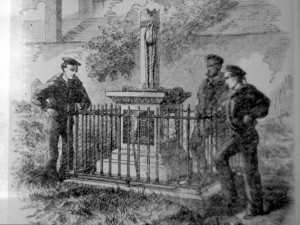
AJAX memorial in Carrickbrennan cemetery
The mountain waves were raging with a tremendous roar,
And the unchained tempest did it’s best upon the Kingstown shore.
Up high upon the mountain waves, were noble vessels tossed,
Some were dashed upon the rocks and very soon were lost.
111.
And yet the dreadful storm raged, and still the sea ran high –
Thus were there seen in dire distress, two vessels drifting nigh,
On mountain waves careering, their sails and rigging tore –
They seemed to be approaching the worst part of the shore.
1V.
One proved to be the NEPTUNE, with a crew of five good tars;
The other was the INDUSTRY with four lashed to the spars –
To see those gallant sailors, it would rend your heart with grief,
To hear their dying screams for help, and could find no relief.
V.
Brave Captain Boyd now sees them, and like a sailor true,
Calls on his men to volunteer to try and save the crew,
With lines and ropes on the East Pier, they did their best to save;
But all their efforts were in vain, for death was on the wave.
V1.
Never until that moment was the like e’er seen before –
The frantic waves in fury dashed those vessels on the shore,
Alas – one of those mountain waves spread desolation round,
Brave Captain Boyd and five brave men, by that same wave were drowned.
V11.
When tidings to the AJAX goes, that Captain Boyd was gone,
The hardy tars like children, wept with many a sigh and moan.
The names of those brave heroes I mean to let you hear,
Who lost their lives in such a cause upon that fatal pier.
V111.
There was Curry, Forsyth, Johnson, brave Russel and Murphy too,
Five as stout young fellows as wore the jacket blue.
Likewise their noble Captain, brave Boyd of high renown,
Who long will be remembered by the people of Kingstown.
1X.

Memorial to Boyd in Christchurch, Cheltenham, where his brother Archibald was minister
The angry waves seemed satisfied, the six brave men were drowned.
When the tide an ebb began to make, but few of them were found.
Thousands came to see them in the dead house as they lay,
Waiting for the inquest which was on the following day.
X.
The funeral procession, it was mournfully grand –
The dead march was played before it by the Cameronian band.
The AJAX men walked two and two, with sad and downcast eye,
The shops were closed along the streets and flags were half – mast high.
X1.
Now fare you well brave Captain Boyd, life’s voyaging is o’er,
Farewell gallant Russel, we will never see you more;
Farewell Curry and Forsyth, brave Murphy and Johnson too,
Long will your names respected be, by all the AJAX crew.
X11.
Long live the noble mariners, and the people of Kingstown,
Who, in saving life upon that day, have gained themselves renown.
Though they were cut and bleeding, among the rocks they ran,
And nobly did they persevere to save their fellow man.
J.J.M., Kingstown.

HMS AJAX in Kingstown Harbour
Another memorial over the graves of the men from AJAX who were lost can be seen in Carrickbrennan graveyard. It consists of a square plinth with sculpted panels depicting the events on the East Pier. It is surmounted by a broken ships mast which once had a block and a rope in marble which have long since disappeared. This was paid for by Commander Yelverton of the Coastguard. There is a very visible memorial on the East Pier of Dun Laoghaire Harbour near to where the tragedy took place. This is the granite obelisk on the upper level of the pier with the name BOYD incised on a plinth. Further down are the names of the five seamen from AJAX who were lost, John Curry, Thomas Murphy, Alexander Forsythe, James Johnstone and John Russell. This was erected at the expense of the members of the Royal St. George Yacht Club, of which Boyd was a member, and was designed by Trevor Owen. There are at least three other memorials to Captain Boyd, one in Christchurch, Cheltenham, where his brother was a minister for eighteen years, a carved marble scroll in Saint Ann’s church, Portsmouth which was erected by his fellow naval officers, and in Saint Columb’s Cathedral in Derry, there is an inscribed work in marble, with a carved bas-relief panel that depicts Captain Boyd in a stance similar to that of the Farrell statue. It might seem odd that there is no mention or memorial to the crew members of the colliers who were lost but it must be remembered that such shipwrecks were commonplace in those times and hundreds of poor seamen perished almost every year in similar circumstances, particularly in the coal trade in which many ships were regarded as being sub-standard and under-manned or, as it was euphemisticly put in a parliamentary paper of the day, “imperfectly appointed” and many were justifiably known as coffin ships. The same paper mentioned,
It seems unquestionable that a large proportion of colliers are vessels that have been excommunicated from foreign service and thrown on the market to be sold at low prices, some for £400 or £500 and bought by shareholders out of earnings derived from business that gives them no knowledge or experience of what vessels ought to be. They are then covered by high insurance in the ‘clubs’ or local insurance companies distinct from Lloyds and sent to sea, many of them to perish with their crews whilst their owners live on the insurance. But alas for the widow and the orphan.
The Merchant shipping Act governing load lines or Plimsoll lines did not come fully into force until 1890.
The following were the surviving personnel from AJAX who took part in the rescue attempt. Hugh McNeil Dyer, John Griffiths, Peter Kane, Bernard Burke, George Farrin, William Wright, George Robertson, William Fynes, Thomas McMagonigal, William Ferguson, William Ferris. William Boyd, Archibald Mclachlin, William Herron, George Doherty. Almost all of these had been injured to one degree or another and they received gratuities from the Admiralty varying from ten pounds to three pounds. All were recommended for, and most received, promotion thereafter.
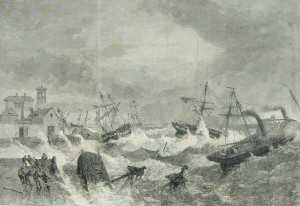
Storm at Kingstown
A number of medals were subsequently awarded. The R.N.L.I. silver medal was awarded posthumously to Captain Boyd and was received by his widow Cordelia. She was also given the Board Of Trade medal on his behalf. This depicts Shipwrecked people and a boat approaching. Silver R.N.L.I. medals were awarded to Lieutenant Dyer and Gunner Farrin. Mr Walsh, the Lloyd’s agent was awarded the Lloyd’s silver medal. At a ceremony on board AJAX on May 30th. Tayleur fund medals were presented by the Lord Lieutenant, to all who had participated in the rescue. This fund was originated to help the survivors and dependents of the wreck of the ship TAYLEUR that was wrecked on Lambay Island off County Dublin in 1854. Medals and monetary awards were awarded by the trustees of the fund for subsequent acts of bravery at sea rescues. Mr. Alexander Parker, the chairman of the fund, said in a speech that he felt that the medals were a more appropriate token of appreciation for the efforts of the rescuers than a monetary award from the residue of the fund which stood at six hundred pounds at that time. After an address by Lord Talbot de Malahide, the Lord Lieutenant made a speech praising all of their efforts and he presented gold medals to Lieutenant Dyer and Mr. John Walsh. Silver medals were presented to the following people, George Farrin, George Robertson, Bernard Burke, Peter Kane, John Griffiths, William Ferris, Thomas McGonigal, William Fynes, William Boyd, William Wright, William Herron, James Beer, John Newham, Luke Malone, Peter Holland, Archibald McLenahan, John Griffiths, George Biddlecomb, George Doherty, Lieutenant William Hutchison, R.N. Harbour Master and Constable Denis Dineen. These were some of the first Tayleur fund medals to be awarded. It appears that few gold medals were awarded and most medals awarded subsequently were of silver. It is unclear as to whether a Tayleur medal was awarded to Captain Boyd posthumously. The obverse of the medal depicts the wreck of the TAYLEUR against the rocks and the legend Tayleur fund for the succour of shipwrecked strangers around the rim. The reverse is plain with the name of the recipient, the date, and the service for which it was awarded engraved. Lord Talbot de Malahide completes the inscriptions. The ribbons have two vertical silver stripes with a band of royal blue in the centre. The medals were made by Richardsons of Dublin. The whereabouts of many of the medals is known. The example in the Went collection in the National Museum of Ireland was awarded to Luke Malone. A silver residual medal with a blank reverse is owned by Father Kit Sheridan of the Pro- Cathedral in Dublin. It was bought at an auction in Liverpool.
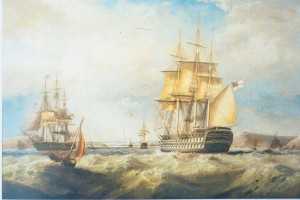
HMS AJAX
Captain Boyd had joined the Royal Navy in 1825 at thirteen as a midshipman. Some sources say he was from Donegal, others say Derry. He served on H.M.S. ARIADNE under the renowned author Captain Marryat who wrote ‘Mr. Midshipman Easy’ and who had devised the Marryat Code of Signal Flags. He was appointed as lieutenant in 1841. During the Crimean war he took part in the attack on Kronstadt in The Baltic and during this campaign he devised new methods in gunnery which enabled gunners to extend their range. Boyd had a reputation for fearlessness in gunboat actions during this war. This was also manifested by the fact that he dived overboard on at least five different occasions during his career to rescue shipmates who had fallen overboard. Boyd was apparently an extremely well liked officer, both ashore and afloat, who inspired great loyalty among his crew members, preferring good example instead of the administration of corporal punishment, which was then still in use in the Royal Navy. He was a man of deep religious convictions and could frequently be heard praying aloud or singing hymns in his cabin. The Captain paid particular attention to the education and the spiritual welfare of young naval cadets under his care and he wrote and illustrated a great many instructional papers for their use on a host of subjects relevant to naval matters. He eventually brought all of these together in the form of an instruction manual, which was approved by the Admiralty and financed by them for publication. This became the standard training manual for young cadets joining the Navy. Captain Boyd evidently had come to the attention of the Admiralty as a man of unusual ability as, just prior to his death, he had been offered command of H.M.S.WARRIOR, the latest and largest iron warship in the world which had just been launched.
H.M.S. AJAX was built in 1809 as a seventy four gun wooden ship of the line, a “wooden wall” exactly like many that had fought at Trafalgar under Nelson. She was stationed in the Mediterranean until 1814 and she was fitted with an auxiliary steam engine in 1846. She was stationed at Cork until 1853. AJAX took an active in the Crimean War, notably at the bombardment of Bomarsund in Finland. She was noted for her poor performance under both sail and steam. In 1858 she came to Kingstown as the Guardship, under the command of Captain Boyd, where she remained until 1864 when she was de-commissioned and broken up. There are several photographs in existence of AJAX moored in Kingstown Harbour as the guard-ship.
In the mid 1980s the author and some colleagues dived along the entire length of the outside of the East Pier of Dun Laoghaire harbour. Several pieces of old wreckage were noted including some pieces of forged iron, some wooden remains, an anchor, and what looked like a ballast mound in different places along the pier.